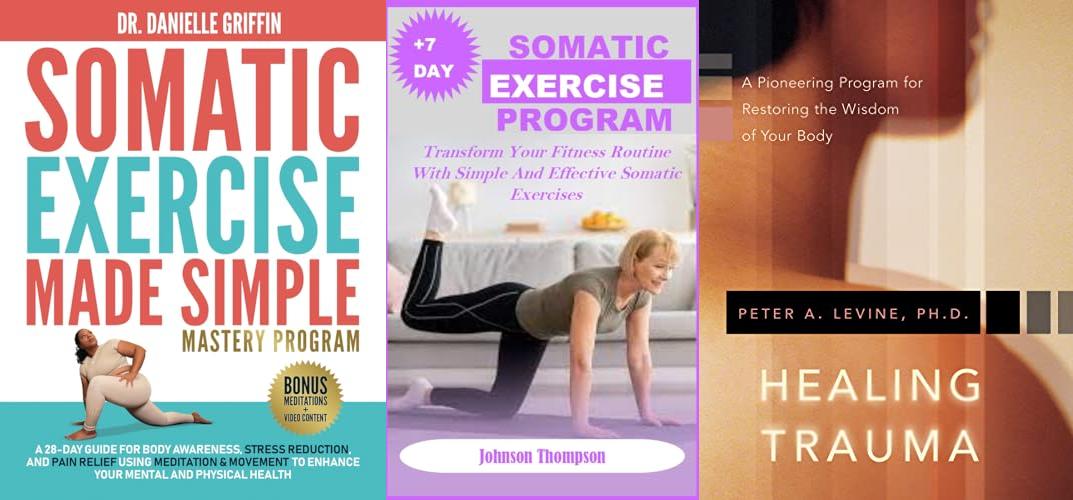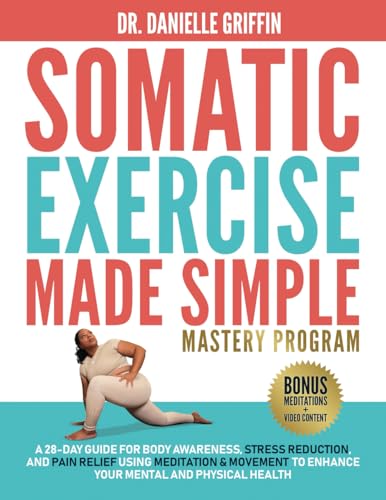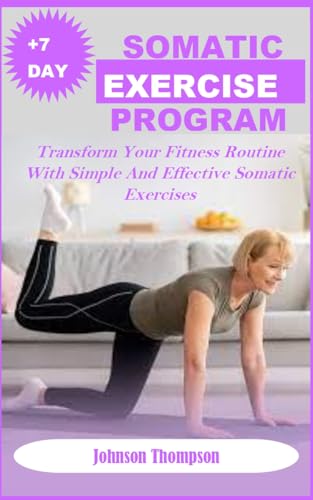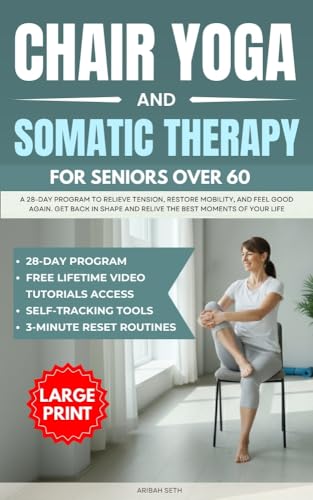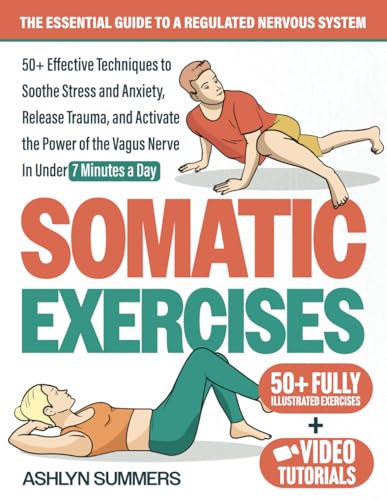Does your body ever feel tight, achy, or just… stuck? You’re not alone. Many of us carry tension from daily life, and finding the right way to release it can feel like a puzzle.
Choosing a Somatic Exercise Program can be confusing. There are so many different types, and it’s tough to know which one will actually help you feel better. You want movement that feels good and brings lasting relief, not just another workout that leaves you sore.
In this post, we’ll explore what makes Somatic Exercise so special. We’ll break down what to look for in a program, helping you understand how it can gently unwind tension and improve your body’s natural movement. By the end, you’ll have a clearer picture of how to find a program that’s perfect for you.
Our Top 5 Somatic Exercise Program Recommendations at a Glance
Top 5 Somatic Exercise Program Detailed Reviews
1. Somatic Exercise Made Simple – Mastery Program: A 28-Day Guide for Body Awareness
Rating: 8.6/10
The Somatic Exercise Made Simple – Mastery Program is a 28-day guide that helps you connect with your body. It uses meditation and movement to help you become more aware of your body. This program aims to reduce stress and ease pain. It’s designed to make your mind and body feel better.
What We Like:
- Clear, easy-to-follow instructions for each day.
- Combines gentle movement with mindfulness for a holistic approach.
- Focuses on practical techniques for everyday stress and discomfort.
- Promotes a deeper understanding of your own body’s signals.
What Could Be Improved:
- Could benefit from more visual aids, like short video demonstrations for some movements.
- Some users might find the pace of 28 days a bit fast if they are completely new to somatic exercises.
This program offers a solid foundation for anyone seeking to improve their well-being through body awareness. It’s a valuable tool for a calmer, more comfortable you.
2. +7DAYS SOMATIC EXERCISE PROGRAM: Transform Your Fitness Routine With Simple And Effective Somatic Exercises
Rating: 9.4/10
Are you looking for a fresh way to move your body and feel better? The +7DAYS SOMATIC EXERCISE PROGRAM is here to help you change your fitness routine. This program focuses on simple and effective somatic exercises. Somatic exercises are all about connecting your mind and body. They help you become more aware of how your body feels and moves. This can lead to less pain and more freedom in your movements. You don’t need any special equipment to do these exercises. Anyone can try them, no matter their fitness level. This program offers a gentle yet powerful approach to improving your well-being.
What We Like:
- Easy-to-follow exercises that can be done anywhere.
- Focuses on mind-body connection for better movement.
- Suitable for all fitness levels, from beginners to experienced individuals.
- Aims to reduce discomfort and improve overall flexibility.
- Promotes a sense of calm and body awareness.
What Could Be Improved:
- More detailed explanations of the “why” behind each exercise could be helpful.
- Visual aids or video demonstrations would enhance understanding.
- Could benefit from suggestions on how to integrate these exercises into a broader fitness plan.
This program offers a unique and accessible path to a healthier, more connected body. Give it a try and see how it can transform your daily movement.
3. Healing Trauma: A Pioneering Program for Restoring the Wisdom of Your Body
Rating: 9.1/10
Healing Trauma: A Pioneering Program for Restoring the Wisdom of Your Body offers a fresh approach to dealing with difficult past experiences. It helps you reconnect with your body’s natural ability to heal. This program guides you through understanding how trauma affects your physical self. It provides tools to help your body release stored tension and stress. You will learn to listen to your body’s signals and trust its inner wisdom.
What We Like:
- Focuses on the body’s natural healing power.
- Offers practical techniques for stress release.
- Empowers individuals to trust their own physical responses.
- Promotes a sense of wholeness and well-being.
- Provides a supportive framework for recovery.
What Could Be Improved:
- Specific examples of exercises could be more detailed.
- More information on how to integrate practices into daily life would be helpful.
- A glossary of terms might benefit some readers.
- The program could benefit from additional visual aids.
This program offers a unique and valuable perspective on trauma recovery. It encourages a gentler, more intuitive path to healing.
4. Chair Yoga & Somatic Therapy For Seniors Over 60: A 28-Day Program to Relieve Tension
Rating: 8.9/10
This Chair Yoga & Somatic Therapy For Seniors Over 60 program offers a gentle and effective way for those over 60 to improve their well-being. It’s a 28-day plan designed to help you release tightness, regain movement, and simply feel better. The program uses chair yoga and somatic therapy, which are both very accessible. Plus, it comes with large print to make reading easy and lifetime access to video tutorials so you can follow along anytime. This makes it a really convenient option for anyone looking to boost their health from the comfort of their own home.
What We Like:
- Large print makes it easy to read the instructions.
- Lifetime access to video tutorials means you can practice whenever you want, as many times as you need.
- Chair yoga and somatic therapy are gentle and safe for seniors.
- The 28-day program provides a structured way to build healthy habits.
- It’s designed to relieve tension and restore mobility, helping you feel more comfortable.
What Could Be Improved:
- The program’s effectiveness might vary depending on individual health conditions.
- More variety in the types of exercises could be beneficial for some users.
This program is a fantastic resource for seniors wanting to improve their physical and mental well-being. It offers a supportive and adaptable approach to feeling good again.
5. Somatic Exercises: The Essential Guide to a Regulated Nervous System: 50+ Effective Techniques to Soothe Stress and Anxiety
Rating: 8.5/10
Feeling overwhelmed by stress or anxiety? This book, “Somatic Exercises: The Essential Guide to a Regulated Nervous System,” offers over 50 proven techniques to help you find calm. It’s designed to help you understand and manage your nervous system. You can learn to ease tension, process difficult experiences, and even boost your vagus nerve’s function. This guide is a valuable tool for anyone seeking more peace and balance in their life.
What We Like:
- Offers a wide variety of over 50 easy-to-follow exercises.
- Explains how to calm your nervous system effectively.
- Helps release stress, anxiety, and past trauma.
- Focuses on the important vagus nerve for better well-being.
- Written in clear, simple language that’s easy to understand.
What Could Be Improved:
- No visual aids or demonstrations are included within the book itself.
- Some readers might prefer more personal stories or case studies to illustrate the techniques.
This guide provides practical tools for taking control of your nervous system. It’s an excellent resource for self-care and achieving greater emotional resilience.
Your Guide to a Smoother, Stronger You: Choosing a Somatic Exercise Program
Feeling stiff? Is your body holding onto tension? A somatic exercise program might be the answer. These programs focus on how your body feels and moves. They help you connect your mind and body. This guide will help you pick the best one for you.
What to Look For: Key Features
When you’re shopping for a somatic exercise program, keep these important features in mind:
1. Instructor Expertise and Approach
- Qualified Instructors: Look for programs led by certified somatic educators or therapists. They understand how the body works and how to guide you safely.
- Gentle and Mindful Approach: A good program emphasizes slow, deliberate movements. It encourages you to pay attention to sensations in your body. Avoid programs that push for fast or forceful movements.
2. Variety of Movements and Exercises
- Diverse Techniques: The best programs offer a range of somatic practices. This could include Feldenkrais, Alexander Technique, or Sensory Awareness. This variety helps you explore different ways your body can move.
- Focus on Breathwork: Breathing is a big part of somatic work. Look for programs that teach you how to breathe deeply and use breath to release tension.
3. Accessibility and Convenience
- Clear Instructions: The exercises should be easy to understand and follow. Good programs use clear language and offer visual aids.
- Flexible Scheduling: Many online programs offer on-demand classes. This lets you exercise whenever it fits your schedule.
4. Progress Tracking and Support
- Feeling Progress: You should start to notice changes over time. This might be less pain, better posture, or more ease of movement.
- Community or Q&A: Some programs offer forums or live Q&A sessions. This lets you ask questions and connect with others.
Important Materials and What They Mean
For most somatic exercise programs, the “materials” are digital.
- Video Lessons: These are the core of most programs. High-quality videos show the movements clearly.
- Audio Guides: Some programs use audio to guide your practice. This is great for when you want to close your eyes and focus inward.
- Written Content: This might include articles, PDFs, or class notes. They explain the principles behind somatic exercises.
What Makes a Program Great (and What Doesn’t)
Factors that Improve Quality:
- Personalized Guidance: Even in a group setting, a good instructor notices and helps individual needs.
- Focus on Sensation: The program teaches you to listen to your body’s signals.
- Safe Environment: You feel encouraged to explore without judgment or fear of injury.
- Clear Explanations: The “why” behind the movements is explained.
Factors that Reduce Quality:
- Pushing Too Hard: If you feel pain, the program is likely not suitable.
- Generic Instructions: The program doesn’t adapt to different bodies or needs.
- Lack of Clear Guidance: You’re left confused about what to do or why.
- Focus on Performance: The program emphasizes achieving a certain pose or outcome, rather than the feeling of movement.
User Experience and Use Cases
People use somatic exercise programs for many reasons.
- Pain Relief: Many find relief from back pain, neck pain, and other chronic aches.
- Improved Posture: Somatic work helps you stand taller and feel more aligned.
- Stress Reduction: The mindful nature of these exercises calms the nervous system.
- Enhanced Body Awareness: You become more in tune with your body’s signals.
- Increased Flexibility and Mobility: You can move more freely and with less effort.
Whether you’re an athlete looking to recover, someone dealing with desk job stiffness, or simply want to feel more comfortable in your own skin, a somatic exercise program can be a valuable tool.
Frequently Asked Questions about Somatic Exercise Programs
Q: What is somatic exercise?
A: Somatic exercise is a type of movement that focuses on how your body feels and moves. It helps you connect your mind and body.
Q: How does somatic exercise help with pain?
A: It helps by teaching you to release muscle tension and improve your body’s natural movement patterns. This can reduce strain and discomfort.
Q: Do I need any special equipment for a somatic exercise program?
A: Usually, no. You might need a comfortable mat to lie on, but most programs only require your body and a quiet space.
Q: How often should I do somatic exercises?
A: Many programs suggest starting with 2-3 times a week. Listen to your body and adjust as needed.
Q: Can beginners do somatic exercises?
A: Yes! Somatic exercises are very beginner-friendly. They are designed to be gentle and adaptable for everyone.
Q: What is the difference between yoga and somatic exercise?
A: Yoga often focuses on holding poses and building strength. Somatic exercise focuses on gentle movements and feeling how your body moves, releasing tension.
Q: Will somatic exercise make me flexible?
A: It can improve your flexibility and range of motion by releasing tight muscles. The focus is on ease of movement, not just stretching.
Q: How long does it take to see results?
A: Some people notice a difference in how they feel after just a few sessions. Others notice changes over a few weeks of regular practice.
Q: Are there any risks involved with somatic exercise?
A: Somatic exercise is generally very safe. The key is to move gently and not push into pain. Always listen to your body.
Q: Where can I find a good somatic exercise program?
A: You can find programs online through websites that offer fitness classes or through specialized somatic education centers. Look for certified instructors.
In conclusion, every product has unique features and benefits. We hope this review helps you decide if it meets your needs. An informed choice ensures the best experience.
If you have any questions or feedback, please share them in the comments. Your input helps everyone. Thank you for reading.
